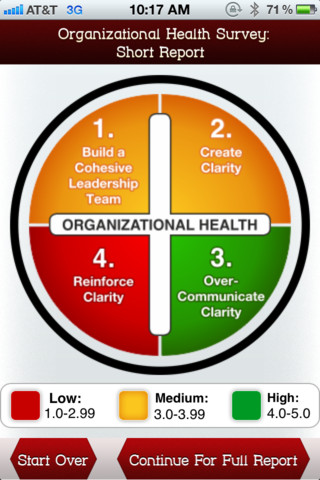In Your Blindside – The Value of Collective Intelligence we discussed the importance of your leadership’s team ability to feel vulnerable in order to develop trust.
In The Advantage, Patrick Lencioni’s latest business contribution, he describes four elements that describe a Healthy Organization. In fact you can take a short survey to find how you measure up at his website and scrolling down the list for Organizational Health Survey.
What is organizational health? What’s it look like?  Lencioni describes organizational health this way. “A good way to recognize health is to look for the signs that indicate an organization has it. These include minimal politics and confusion, high degrees of morale and productivity, and very low turnover among good employees.”
Lencioni describes organizational health this way. “A good way to recognize health is to look for the signs that indicate an organization has it. These include minimal politics and confusion, high degrees of morale and productivity, and very low turnover among good employees.”
Lencioni believes the single greatest advantage any company can achieve is organizational health. Most companies ignore it. Many company executive feel it’s too “touchy feely” and disdain it.
Lencioni feels that the classic areas of business—finance, marketing, strategy, are incremental and fleeting. Due to advancing technology it’s harder than ever been to maintain a competitive advantage based on intelligence or knowledge. Information just changes hands too rapidly today.
Health as Lencioni’s title implies Trumps—Intelligence. Why? Because an organization that is healthy will inevitably get smarter over time. People in a healthy organization, starting with the leader, learn from one another, identify critical issues, and recover quickly from mistakes. Imagine your business without politics and confusion getting in the way. Your people can cycle through problems and rally around solutions faster than your dysfunctional and political competitors do. This creates an environment where employees do the same.
Contrast this with those smart organizations. Smart organizations don’t have any greater chance of getting healthier by virtue of their intelligence. “In fact, the reverse may actually be true because leaders who pride themselves on expertise and intelligence often struggle to acknowledge their flaws and learn from peers. They aren’t as easily open and transparent with one another, which delays recovery from mistakes and exacerbates politics and confusion. That’s certainly not to say that being smart isn’t desirable, just that it provides no inherent advantages for becoming healthy.”
This should be a reminder of the importance of building trust in your business. It requires the leadership team to be vulnerable. That starts at the very top of the organization.
What appeals to me about The Advantage is the Discipline which Lencioni describes his four elements for building a healthy organization. Three of these are patterned after the foundational principles we preach with Strategic Discipline.
Here are Lencioni’s Four Disciplines that comprise The Advantage:
Discipline 1: Build a Cohesive Leadership Team
Discipline 2: Create Clarity
Discipline 3: Over-Communicate Clarity
Discipline 4: Reinforce Clarity
To learn more about Lencioni’s The Advantage go here. I’ll be referring to his work several times in the blogs ahead.
Originally I intended to include Jim Stengel, a speaker at this week at the Atlanta Growth Summit, and the author of Grow - How Ideals Power Growth and Profit at the World's Greatest Companies because it so strongly provides data to support Lencioni’s book.
I’ve discovered there’s so much more material in Grow that really supports this idea of Organizational Health that it requires more than one blog to present it. One of the discoveries in Stengel’s Grow is how great leaders follow common practices, albeit uniquely. He offers five of these common practices which we’ll explore next blog.






.jpeg?width=150&height=135&name=Hand%20with%20marker%20writing%20the%20question%20Whats%20Next_%20(1).jpeg)

